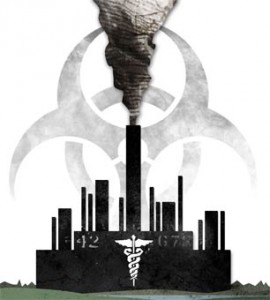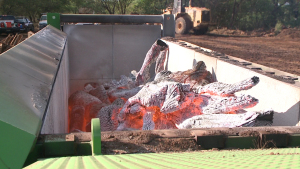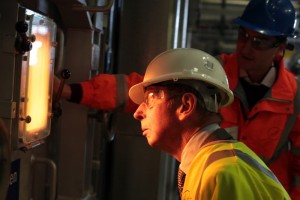Doubel Combustion Chamber
All Incinerators are Doubel Combustion Chamber with One Fuel Burner Each. After Burner Technology for Completely Combustion and Cleaner World.
Read MoreHigh Temperature Incineration
Temperature Range 800 Degree to 1200 Degree in Combustion Chamber. Temperature Thermocouple Monitor and Controller. High Quality Fire Brick and Refactory Cement.
Read MoreGet Lastest News
There are latest incinerator news like technical, public news, business tender for medical waste incinerator,animal incineration, pet cremation
Read MoreNanjing Clover Medical Technology Co.,Ltd.
Email: sales@clover-incinerator.com | Tel: +86-25-8461 0201
Regular model incinerator for market with burning rate from 10kgs to 500kgs per hour and we always proposal customer send us their require details, like waste material, local site fuel and power supply, incinerator operation time, etc, so we can proposal right model or custom made with different structure or dimensions.
Incinerator Model YD-100 is a middle scale incineration machine for many different usage: for a middle hospital sickbed below 500 units, for all small or big size family pets (like Alaskan Malamute Dog), for community Municipal Solid Waste Incineration, etc. The primary combustion chamber volume is 1200Liters (1.2m3) and use diesel oil or natural gas fuel burner original from Italy.
Latest Post
Watching Our Health Go Up in Smoke
The medical waste incineration industry was given birth to in the late 1980s by the confluence of two high profile media circuses: one – the HIV hysteria – and two – multiple media accounts of bags of syringes, needles, plasma bags, IV tubing, bottles of pills and even body parts washing up on the shores of some of the most popular resort beaches on the East Coast stretching from Maine to Florida. In 1987, in Indianapolis, Indiana, 12 children were found playing with HIV-infected vials of blood that came from an unsecured dumpster used by a medical clinic.
In a classic case of the cure being worse than the disease, the knee-jerk response was a widespread call to burn hospital waste so that the various avenues of incompetence, corruption and profiteering that led to dirty needles washing up on exclusive beaches could be closed down through a back door. Little thought was applied to the consequences of incineration, until plumes of black clouds began billowing from hospital complexes. Neighbors complained, air pollution research showed that those emissions were indeed dangerous and the Environmental Protection Agency (EPA) became involved.
Eventually the number of incinerators contracted dramatically, but in part because “centralized” incinerators became an easy solution. Hospitals washed their hands of the matter by allowing their waste to be burned in someone else’s backyard.
As a result, Stericycle, headquartered in Lake Forest, Illinois, became the king of the medical waste incineration industry, operating six large incinerators throughout the country, including one of the largest medical incinerators west of the Mississippi in the heart of the most heavily populated part of Utah, the North Salt Lake subdivision of Foxboro, a few miles from my house. Stericycle now receives the medical waste of eight surrounding states there.
The relationship between Stericycle and Foxboro has always been tense. Efforts to shutter Stericycle were launched as long as 10 years ago by a handful of citizens concerned about the toxic brew that billows out of Stericycle’s short smokestack. It’s no surprise that burning medical waste, just like burning fossil fuels or just about anything else, creates a pollution potpourri of hazardous chemicals and gases, heavy metals and particulate matter.
Indeed, citizens’ concerns are validated by hundreds of studies showing multiple adverse health outcomes among people exposed, including higher rates of cancers like childhood leukemia and adverse pregnancy outcomes that I have written about in a previous essay.
The repercussions of the toxic incinerator emissions are made even more disturbing when adding the realization that the medical waste incineration industry was born on a false premise – that hospital pathogens must be incinerated. An EPA report dating back 25 years cites numerous studies showing hospital waste presents no more risk of spreading infection than household waste – which harbors virtually all the same viruses and bacteria. In fact, according to the Society for Hospital Epidemiology of America, “Household waste contains more microorganisms with pathogenic potential for humans on average than medical waste.” So why single out medical waste? Scalpels and needles can be shredded without incineration.
Many of the toxic chemicals and heavy metals in hospital waste are not destroyed by incineration. In fact, burning medical waste is the worst possible way to manage it.
While merely landfilling is a less than perfect solution, the possibility of contamination of usable groundwater is theoretical, not a certainty. Whereas with incineration, the emissions enter the air shed we all breathe from, guaranteeing public exposure, especially for those closest to the incinerator. The ash left over from incineration may be a smaller volume than the original waste, but it is much more toxic, and eventually has to be landfilled anyway.
Incineration does not prevent disease; it actually spreads disease. Incineration not only does not remove toxins; it actually creates new ones and concentrates, mobilizes and redistributes existing ones. Emissions from incinerators are probably the most toxic type of air pollution there is, contaminated with the deadliest compounds known to science, designated by the EPA as “HAPs” (hazardous air pollutants), which includes dioxins, benzene, PAHs (polycyclic aromatic hydrocarbons), furans, heavy metals and radioactive elements. Medical incinerators have even more deadly compounds not found in any other source, like residuals from chemotherapy drugs and even prions, the highly infective proteins that cause the 100 percent fatal human “Mad Cow” disease (which are much more common in human tissue than previously realized, and not reliably deactivated by incineration).
State health departments and environmental agencies are fond of claiming that toxicology assessments of the concentrations of many of these toxins are small enough to be written off as “safe.” The Utah State Health Department measured dioxin levels in the soil around Stericycle and declared the levels to be below any threshold of concern. If the devil is often in the details, in this case, the devil lies in the ignorance of the details.
Those toxicology assessments ignore the biologic complexity of the exposure. Many of these toxins are bioaccumulative, meaning they build up in the human body insidiously over time, and in even higher concentrations in certain critical organs and tissues.
Lipophilic (fat-like) toxins like dioxins highly concentrate in human breast milk. Nursing infants consume 10 to 20 times as much dioxin as the average adult. No toxicology assessments are ever based on the amount of dioxins in the human breast milk of people who live near incinerators, yet that undoubtedly is where dioxins wreak their greatest havoc on public health. Nor do those assessments consider the consequences of lipophilic toxins crossing the placenta that will primarily end up in the developing fetal brain because fat comprises about 60 percent of brain structural matter, and is the primary fat reservoir in the fetus.
Recently a new documentary was released that significantly raises the stakes in the long and sorry saga of this dying industry whose flagship corporate villain is Stericycle. The film features an undercover interview with an anonymous former Stericycle employee giving a credible, extraordinarily detailed account of fraudulent, illegal management practices far beyond what prompted the criminal investigation by state and federal law enforcement. The whistle-blower alleges shocking disregard for public and employee safety by Stericycle management – including directing employees to ignore the Geiger counter giving radioactive readings of the waste and to burn it anyway. Furthermore, he stated, the Geiger counter didn’t work much of the time.
While radioactivity is an inherent part of hospital waste, one of the few appropriate provisions in Stericycle’s permit is a prohibition of burning anything radioactive, and with good reason. No amount of radiation exposure is safe. Quoting from an article in the New England Journal of Medicine, “Mutagenic effects theoretically can result from a single molecular DNA alteration . . . every molecule of a carcinogen is presumed to pose a risk.”
In fact, the medical community is now much more cautious about the radioactive burden of many of our common diagnostic tools, like CAT scans, because of this growing recognition. Even low dose radiation exposure can damage chromosomes, alter gene expression and lead to cancer, brain diseases, immune disorders, birth defects and miscarriages – all of which North Salt Lake residents believe they have experienced in excess in their neighborhoods.
The ex-employee described management deliberately rigging the company scales and ignoring their permitted weight limit, a likely reason the state caught them exceeding their dioxin limit by 400 percent. Add to this the revelation that Erin Brockovich’s investigative team found dioxin concentrations in Foxboro homes to be inversely proportional to the distance from the incinerator. The home closest to Stericycle had 17 times the level of dioxins in its attic that would be considered average for an industrial area.
Incineration is widely recognized by international health organizations as an unnecessary, dangerous means of handling waste. Over 98 percent of medical incinerators have closed in the last 15 years – leaving a handful of communities like Foxboro to take most of the “hits for the team.” Utah’s governor, Gary Herbert, could close Stericycle on the basis of necessary public health protection, but he is loath to do so because he functions under the fog of the conservative mindset, that protection of business inherently has priority.
The whole medical incineration industry was a huge mistake right from the start, but Stericycle seems to have achieved immortality simply because someone is making money from it. The gnawing outrage of Stericycle is just a microcosm of the endemic failure of countless public policies held hostage to capitalism. Science, common sense, proportion, justice and human decency get thrown under the bus initially by fear and ignorance, and held there in perpetuity by ideology, exploitation and greed. We watch the same play over and over again with a different cast, be it gun control, the wealth gap, ISIS, our war addiction, GMO labeling, chemical and pesticide dysregulation, factory farming – and of course, the climate crisis. It makes me wonder whether we are not already living on the planet of the apes.
Outrage: Excalibur, the Pooch Exposed to Ebola, is Killed! Murderers!
“The pet dog of a Spanish Ebola victim was put down today over fears it could transmit the disease, prompting a wave of outrage from animal lovers who chanted `murderers` outside her home.
ebola
Madrid regional government health spokesman Javier Rodriguez confirmed tonight that Teresa Romero Ramos`s dog Excalibur had been put down, adding: “Unfortunately we had no other choice.`
The animal was sacrificed inside Mrs Romero Ramos`s home and its body driven out of the house in a white van just before 6.30pm local time to a nearby incinerator.”
Daily Mail
In spite of an online viral campaign to save the life of Excalibur, the pooch exposed to the Ebola virus, Spanish authorities murdered the friendly pooch today.
A Madrid government health spokesperson issued a statement explaining: We had no other choice. Bullcrap, they could have isolated and quarantined the pooch for the mandatory 21 days.
Excalibur`s body was taken to a nearby incinerator as if he was nothing more than an infected blanket, or medical waste.
The killing of Excalibur is an outrage to dog lovers all over the world, let`s hope it`s not a mortal blow to Teresa Romero Ramos, who is in a hospital battling for her life. She loved her pooch to death; let`s hope she will find the will to overcome the double tragedy of the death of her dog and Ebola.
More burners to incinerate invasive beetle headed to Hawaii
The Hawaii Department of Agriculture says we’re only in the beginning stages of the eradication and it could take years to wipe out.
“This is a very serious pest. It affects not only coconut palms, but all other palms. It will also affect bananas, pineapples, plumerias, so parts of what we know of Hawaii could disappear because of this beetle,” said Rob Curtiss, pest control branch manager for the Hawaii Department of Agriculture.
On Wednesday, KHON2 got a look at a new machine that’s being used to get rid of the beetles and the mess they leave behind.
It’s called an air curtain burner, a large incinerator that can burn any plant or green waste that may be infested with the beetle.
air curtain burner (1)
“These are trees that were cut down on base, about 120 of them,” Curtiss said. “We want to burn them before they’re able to get infested. It’s the best method we have of getting rid of the material.”
“It’s quicker. It’s more efficient,” said Lonnie Felsie, Naval Facilities Engineering Command. “It burns and then the residue that’s left is almost nothing. It’s five percent of whatever volume we put inside and so the ashes are almost nothing.”
One air burner costs around $80,000 and shipping it to Hawaii costs about $16,000. The one currently being used is owned by the U.S. Department of Agriculture.
The military also has four air burners on order, and the state Department of Agriculture plans to order one within the next couple of months.
“So we’ll have six of these machines on Oahu, destroying materials that could be infested by CRB,” Curtiss said.
The CRB has also been found at Barbers Point and Campbell Industrial Park, but traps have been placed all across Oahu.
State officials want to make sure it doesn’t spread any further.
“Just be aware of what this insect is and help us out by calling it in if you see something,” Curtiss said.
Hazardous waste plant awash in fines
If Clean Harbors Aragonite were a drunk driver, the Tooele County hazardous waste incinerator would have been taken off the road years ago.
Instead, the plant is an alleged serial violator of its state waste handling permit, racking up monetary penalties nearly every year for a decade — a total of more than $1 million.
And more are on the way.
Fines for violating environmental regulations are intended to deter future bad behavior, but activists are wondering whether the incinerator’s owners are getting the message.
Last month the Utah Division of Solid and Hazardous Waste reached a proposed agreement with Clean Harbors Aragonite LLC to resolve 21 violations documented in 2012. Under a deal that is subject to public comment through Oct. 17, the company will pay $71,155.
While those penalties were being negotiated, the division last April slapped Clean Harbors with a 32-count notice of violation — the company’s tenth since acquiring the plant in 2002 — based on inspections completed in 2013.
Officials with the plant’s corporate parent in Massachusetts downplayed the alleged violations as “administrative in nature.”
“There’s no significant risk to human health or the environment,” said Phillip Retallich, Clean Harbors’ senior vice president for compliance and regulatory affairs. “Our incinerator is state-of-the-art. It always achieves the rigorous compliance requirements for the Clean Air Act’s high-temperature emissions.”
Most of the allegations target reporting errors, failure to properly track and categorize waste, and other record-keeping violations.
“Having an inaccurate waste characterization could lead to mismanagement of the waste, such as placing flammables in places not designed for those hazards or placing incompatibles near each other, or it could result in excessive emissions,” Utah environmental regulators wrote in a report.
Retallich emphasized the firm has never admitted any allegations, but still pays the fines.
While regulators agree the public should not rush to conclude Clean Harbors is a public health menace, environmentalists are less charitable.
“It’s a dizzying array of violations,” said Brian Moench, president of Utah Physicians for a Healthy Environment. “It depicts a facility that isn’t nearly as safe as it should be. It paints a picture of significant hazards for the employees. It’s indicative of an attitude that is way too lax toward the material they are handling.”
Moench noted the records show the Aragonite incinerator processes dangerous materials like asbestos-bearing vermiculite and last year suffered 10 “bypasses,” where potentially carcinogenic smoke is released directly into the atmosphere.
“Those events can be extraordinary in terms of release of toxic emissions,” Moench said.
To be fair, the Aragonite plant’s alleged missteps have never included illegal discharges of pollution or covering up offenses, according to a 19-page compliance history compiled by the Utah Department of Environmental Quality.
A massive firm providing a variety of industrial services at locations across the nation, Clean Harbors is licensed in Utah to burn numerous hazardous materials, including infectious medical waste, pharmaceuticals and corrosive chemicals.
“Each requires different burn parameters, feed rates and so forth. They stage and batch it just right,” said Scott Anderson, director of DEQ’s hazardous waste division. “It’s a highly technical facility with one of the most prescriptive permits in the nation.”
Duke of Kent officially opens Billingham incinerator
His Royal Highness, the Duke of Kent yesterday (8 October) officially opened SITA consortium’s energy-from-waste (EfW) facility at Billingham, Teesside.
Built as part of the SITA UK, Lend Lease Infrastructure (EMEA) Ltd, and I-Environment Investments Ltd (ITOCHU Corporation), the facility forms part of the consortium’s 25-year waste management contract with the South Tyne & Wear Waste Management Partnership (STWWMP), which comprises Gateshead, South Tyneside and Sunderland councils. Construction of the facility at took three years and was completed in April of this year.
Aerial view of the Billingham site. The new facility (comprising lines four and five) is situated on the left.
Situated adjacent to SITA’s existing three-line EfW facility in Billingham, the two-line plant (pictured, bottom left) can process up to 256,000-tonnes of residual waste per annum, of which, 190,000 tonnes will come from the STWWMP. After being filtered of recyclables, the residual waste will be burnt at high temperatures to produce sufficient electricity to power around 30,000 homes.
It is hoped the facility, which is operated by 42 full-time staff, will allow the three councils to reduce their reliance on landfill and boost their recycling rates. (A further 24 jobs have been created in the operation of three new waste transfer stations developed at Wrekenton in Gateshead, Middlefields in South Tyneside, and Hendon in Sunderland. These allow the waste to be sorted for recycling before loading the residual waste into larger vehicles for transport to Teesside.)
‘Delivering a sustainable source of energy’
Edward Campbell-Preston, SITA UK Graduate Engineer, shows HRH The Duke of Kent the furnace
Speaking of the visit, David Palmer-Jones, Chief Executive Officer for SITA UK, said: “The South Tyne & Wear Waste Management Partnership’s investment in this new infrastructure shows how local authorities can meet their commitments to divert waste material from landfill and, at the same time, deliver a sustainable source of energy. SITA UK is delighted to play a part in helping the North East put its waste to good use.
“On behalf of SITA UK and the South Tyne & Wear Waste Management Partnership, I am delighted and honoured to welcome His Royal Highness to formally open our new energy-from-waste facility.”
Councillor Peter Mole MBE, Chair of the STWWMP’s Joint Executive Committee, added: “These new developments are the realisation of our very ambitious plans to significantly reduce our reliance on landfill and provide our residents with a greener waste management service. Thanks to these new facilities, we are proud to be able to say that we now divert over 95 per cent of our waste away from landfill and, instead, put it to good use – either by recycling it into new products and compost or treating it to produce electricity. In fact, even the ash that comes from burning the waste is recycled into building materials.”
The opening of the new facility was welcomed by Resource Minister Dan Rogerson, who said: “We are diverting more waste from landfill year on year and I am pleased that South Tyne & Wear Management Partnership’s energy from waste facility is officially up and running.
“As we continue to move towards a more circular economy it is good to see Gateshead, South Tyneside and Sunderland local authorities working together to deliver this commendable example of effective, efficient waste management.”
The £727-million contract was one of the first waste private finance initiative (PFI) projects funded by banks to reach financial close under the competitive dialogue process. The funders include the Green Investment Bank, Credit Agricole, BBVA and Natixis.
SITA has recently submitted planning permission to build a sixth processing line at the same site, and is in the process of building a separate EfW facility in nearby Wilton, as part of SITA Sembcorp’s 30-year Public Private Partnership (PPP) contract with the Merseyside Waste Disposal Authority (MWDA).













